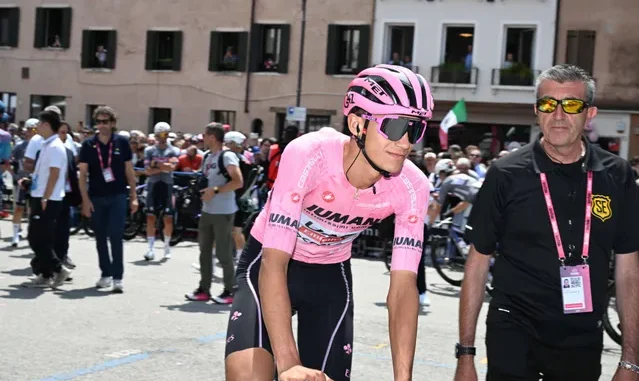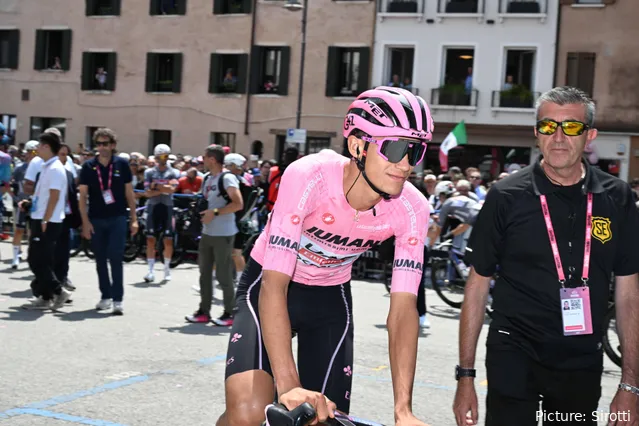
Isaac Del Toro’s Grit and Power on Display asE- joins e Group Behind Wout van Aert.
In the high-stakes world of professional cycling, moments of brilliance are not just about winning races—they are about showing heart, resilience, and the kind of raw power that turns heads. This week, during a riveting stage of one of cycling’s major races, 20-year-old Isaac Del Toro gave fans and analysts such a moment when he heroically rode himself back into a formidable group where Belgian powerhouse Wout van Aert was laying down a fierce tempo at the front.
For those watching the race unfold live, it was a brief moment, maybe a few minutes at most. But for analysts and seasoned riders, it was a telling sign: the young Mexican rider, still new to the WorldTour peloton, not only endured the punishing pace but clawed his way back into a group where even experienced riders were struggling to hold on. It was a feat that spoke volumes about Del Toro’s promise, physical capacity, and mental fortitude.
A Brief Background: Who Is Isaac Del Toro?
Isaac Del Toro is a name that has been on many insiders’ lips for the last year, but for casual fans, he is still a relative newcomer. Born in 2003 in Baja California, Mexico, Del Toro rose through the ranks with impressive performances on the amateur scene. His breakout came in 2023 when he won the prestigious Tour de l’Avenir—a race known for spotlighting future Grand Tour stars. Past winners include Egan Bernal, Tadej Pogačar, and Nairo Quintana.
Del Toro’s racing style is defined by his fearlessness, ability to climb, and a diesel engine that keeps revving when others begin to fade. Signed by UAE Team Emirates, he entered the WorldTour in 2024 with expectations sky-high. And so far, he’s shown flashes of brilliance. But this latest display—riding himself back to a group led by Wout van Aert—felt like a declaration: Del Toro is no longer just a talented prospect. He’s ready to play among the elite.
The Moment: Rejoining the Group Behind Wout
The scenario was dramatic and punishing. Midway through a mountainous stage that featured multiple categorized climbs and explosive breakaways, the peloton was splintering under pressure. As the gradients steepened and the tempo surged, riders began to lose contact. Among them was Del Toro, caught out slightly during a surge on the penultimate climb.
For many young riders, that would have been the end of their day in terms of contention. Once dropped, especially from a group where a rider like Wout van Aert is setting the pace, it’s incredibly difficult to bridge back. Van Aert, known for his relentless work ethic and motor-like ability on climbs and flats, is often the final nail in the coffin for those unable to respond to accelerations.

Yet, Del Toro didn’t fold. Instead, he dug deep, finding reserves of strength and rhythm. What followed was a remarkable individual time trial of sorts, as he paced himself back through the remnants of the peloton, overtaking dropped riders, and eventually making contact with the select group.
It was no ordinary chase. This wasn’t flat terrain or a tailwind-assisted highway. It was a climb under pressure, where every watt counted and where pacing mistakes could end in a complete blow-up. That Del Toro managed it so cleanly is a sign of his developing maturity and tactical intelligence—not just raw power.
Analyst Reactions: Power and Poise
Cycling analysts and commentators immediately took note. “He rides himself back into the group where Wout van Aert is pacing,” one analyst remarked on live coverage. The tone was one of astonishment, not just because Del Toro returned to the group, but because of who was leading it. Van Aert is known for dropping top-tier climbers when he chooses to push the pace; anyone able to claw back during such a moment is showing world-class resilience.
“This is a really impressive ride from Del Toro,” said a former pro on Eurosport’s post-stage show. “You don’t fake a comeback like that. That’s pure strength and determination.”
Another analyst added, “He’s making the transition from being a promising under-23 to a genuine WorldTour player. And it’s happening quickly.”
Physical Capacity: What It Takes
To truly appreciate the feat, it’s important to understand the physical demands at play. Riding back into a group pacing at 5.5 to 6 watts per kilogram for extended periods requires not just talent but top-end fitness. Del Toro’s ability to produce sustained power, while also managing his effort to avoid going into the red too early, reveals a physiological capacity beyond his years.
While we don’t have the exact power data from his effort, estimates based on terrain, speed, and group dynamics suggest Del Toro may have averaged upwards of 370–400 watts during his chase, depending on his weight. That’s elite-level output, especially under stress.
Moreover, it wasn’t just power—it was control. Many riders in that situation panic, overexert themselves, and explode before making contact. Del Toro’s measured approach shows a maturity often found in riders with five to ten years of pro experience.
A Sign of Things to Come
Del Toro’s ride is more than just a highlight reel moment. It suggests he’s developing into a rider capable of GC contention in week-long stage races and, perhaps eventually, in Grand Tours. His climbing abilities, combined with solid time-trial skills and a fearless racing attitude, make him a versatile asset.
UAE Team Emirates, already stacked with talent including Pogačar, Ayuso, and Almeida, has managed to nurture a highly competitive environment that still allows young riders to grow. Del Toro seems to be thriving under this pressure and mentorship. And performances like this only reinforce the idea that the team’s investment in him is already paying off.
Fans Take Notice
Social media lit up with praise for Del Toro’s effort. Clips of his chase and reintegration into the group were circulated widely. Many fans drew comparisons to riders like Bernal and Pogačar in their early years—climbers who could suffer but never cracked, and who always found a way to stay in the fight.
One fan tweeted: “If Del Toro keeps riding like this, Mexico has a future Grand Tour winner in its ranks. That was huge.”
Another wrote: “Van Aert pacing is usually a death sentence. Del Toro just rode himself back into that group like it was nothing. Unreal.”
Conclusion
Cycling is a sport defined by suffering, strategy, and moments of resilience. Isaac Del Toro gave us one of those moments—a gritty, explosive effort that redefined what we thought he could do. By riding himself back into a group led by none other than Wout van Aert, he not only showcased his physical talent but announced himself as one of the most exciting young riders in the peloton.
The 2025 season is still young, and there are many mountains left to climb. But if this performance is any indication.
Leave a Reply